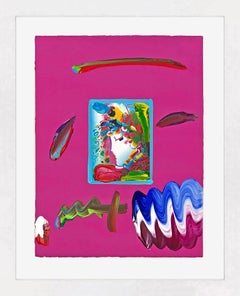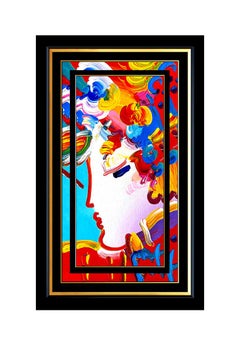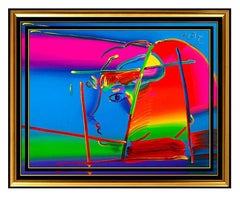Peter Max Blushing Beauty
2010s Pop Art Mixed Media
Paper, Mixed Media, Acrylic, Lithograph
Recent Sales
2010s Pop Art Figurative Paintings
Canvas, Acrylic
1980s Pop Art Abstract Paintings
Canvas, Acrylic
1990s Pop Art Figurative Paintings
Canvas, Acrylic
1980s Pop Art Portrait Prints
Screen
Late 20th Century Pop Art Portrait Prints
Screen
1990s Pop Art Portrait Paintings
Acrylic
Early 2000s Pop Art Figurative Paintings
Acrylic, Canvas
1990s Pop Art Figurative Prints
Lithograph, Offset
2010s Pop Art Mixed Media
Paper, Mixed Media, Acrylic, Lithograph
Early 2000s Pop Art Figurative Paintings
Acrylic, Offset
21st Century and Contemporary Contemporary More Prints
Lithograph
1990s Pop Art Figurative Paintings
Mixed Media, Acrylic
1990s Pop Art Portrait Paintings
Ink, Watercolor
Early 2000s Pop Art Figurative Paintings
Mixed Media, Acrylic
1990s Pop Art Figurative Drawings and Watercolors
Ink
1990s Pop Art Portrait Paintings
Mixed Media, Acrylic
1990s Surrealist Paintings
Acrylic
1990s Contemporary Figurative Paintings
Ceramic, Acrylic
Peter Max Blushing Beauty For Sale on 1stDibs
How Much is a Peter Max Blushing Beauty?
Peter Max for sale on 1stDibs
Born Peter Max Finkelstein in Berlin in 1937, psychedelic Pop art icon Peter Max spent the first part of his childhood in Shanghai after his parents emigrated from Germany to flee the Nazis. While there, Max developed his deep interest in American pop culture — namely comic books, jazz and cinema. Max’s paintings, graphic design, prints and illustrations, which were inspired by these interests, were also informed by his experience with synesthesia, a sensory condition that causes him to see music and hear color.
After relocating to Haifa, Israel, then Paris, where he spent a significant amount of time in sketching classes at the Louvre, a teenage Max and his family finally moved to the United States, settling in Brooklyn. Max enrolled in the Art Students League of New York in 1956, training under Frank J. Reilly, and then the School of Visual Arts. Throughout art school, Max focused on photorealism, but he found the style too restrictive. When he graduated and opened his graphic design studio with friends in 1962, he began experimenting with abstraction and color — just in time for the psychedelic era.
The technicolor works for which Max would become known are characterized by big and bold graphic qualities — not dissimilar to what you’d find in his beloved comic books. Some deeper themes emerged across his work too: Max spent a good portion of the 1960s and 1970s creating his signature cosmic style, inspired by his fascination with astronomy and Eastern philosophies.
For Max and his partners, the graphic design business was highly successful, with commissions rolling in from advertising agencies, magazines and even Hollywood in the form of movie posters. The artist was featured on the cover of Life in 1969, and by the 1970s, he was practically a household name.
Max's body of work extended into product design, including a line of clocks for General Electric, while his domination of the commercial art scene continued for decades. He was commissioned to paint a postage stamp honoring the World’s Fair of 1974 (Expo ‘74); a Statue of Liberty series in which some proceeds went on to fund the statue’s restoration; posters and other advertising materials for major events like the Super Bowl, the U.S. Open and the Grammys; a Dale Earnhardt race car; and even the hull of the Norwegian Breakaway cruise ship.
Commercial activities aside, Max has long been the subject of many museum exhibitions, from his first solo show in 1970, “The World of Peter Max,” at the M.H. de Young Memorial Museum in San Francisco to 2016's “Peter Max: 50 Years of Cosmic Dreaming” at the Tampa Museum of Art in Florida. Today, his work belongs to the collections of the Museum of Modern Art in New York, the Philadelphia Museum of Art and other institutions.
Find original Peter Max lithographs, paintings, signed art and other works for sale on 1stDibs.
A Close Look at Pop Art Art
Perhaps one of the most influential contemporary art movements, Pop art emerged in the 1950s. In stark contrast to traditional artistic practice, its practitioners drew on imagery from popular culture — comic books, advertising, product packaging and other commercial media — to create original Pop art paintings, prints and sculptures that celebrated ordinary life in the most literal way.
ORIGINS OF POP ART
- Started in Britain in the 1950s, flourished in 1960s-era America
- “This is Tomorrow,” at London's Whitechapel Gallery in 1956, was reportedly the first Pop art exhibition
- A reaction to postwar mass consumerism
- Transitioning away from Abstract Expressionism
- Informed by neo-Dada and artists such as Jasper Johns and Robert Rauschenberg; influenced postmodernism and Photorealism
CHARACTERISTICS OF POP ART
- Bold imagery
- Bright, vivid colors
- Straightforward concepts
- Engagement with popular culture
- Incorporation of everyday objects from advertisements, cartoons, comic books and other popular mass media
POP ARTISTS TO KNOW
- Richard Hamilton
- Andy Warhol
- Marta Minujín
- Claes Oldenburg
- Eduardo Paolozzi
- Rosalyn Drexler
- James Rosenquist
- Peter Blake
- Roy Lichtenstein
ORIGINAL POP ART ON 1STDIBS
The Pop art movement started in the United Kingdom as a reaction, both positive and critical, to the period’s consumerism. Its goal was to put popular culture on the same level as so-called high culture.
Richard Hamilton’s 1956 collage Just what is it that makes today’s homes so different, so appealing? is widely believed to have kickstarted this unconventional new style.
Pop art works are distinguished by their bold imagery, bright colors and seemingly commonplace subject matter. Practitioners sought to challenge the status quo, breaking with the perceived elitism of the previously dominant Abstract Expressionism and making statements about current events. Other key characteristics of Pop art include appropriation of imagery and techniques from popular and commercial culture; use of different media and formats; repetition in imagery and iconography; incorporation of mundane objects from advertisements, cartoons and other popular media; hard edges; and ironic and witty treatment of subject matter.
Although British artists launched the movement, they were soon overshadowed by their American counterparts. Pop art is perhaps most closely identified with American Pop artist Andy Warhol, whose clever appropriation of motifs and images helped to transform the artistic style into a lifestyle. Most of the best-known American artists associated with Pop art started in commercial art (Warhol made whimsical drawings as a hobby during his early years as a commercial illustrator), a background that helped them in merging high and popular culture.
Roy Lichtenstein was another prominent Pop artist that was active in the United States. Much like Warhol, Lichtenstein drew his subjects from print media, particularly comic strips, producing paintings and sculptures characterized by primary colors, bold outlines and halftone dots, elements appropriated from commercial printing. Recontextualizing a lowbrow image by importing it into a fine-art context was a trademark of his style. Neo-Pop artists like Jeff Koons and Takashi Murakami further blurred the line between art and popular culture.
Pop art rose to prominence largely through the work of a handful of men creating works that were unemotional and distanced — in other words, stereotypically masculine. However, there were many important female Pop artists, such as Rosalyn Drexler, whose significant contributions to the movement are recognized today. Best known for her work as a playwright and novelist, Drexler also created paintings and collages embodying Pop art themes and stylistic features.
Read more about the history of Pop art and the style’s famous artists, and browse the collection of original Pop art paintings, prints, photography and other works for sale on 1stDibs.
- 1stDibs ExpertFebruary 22, 2021How much a Peter Max painting is worth will be determined by its condition, the presence of a signature, size and other factors. Born Peter Max Finkelstein in Berlin in 1937, psychedelic Pop art icon Peter Max spent the first part of his childhood in Shanghai after his parents emigrated from Germany to flee the Nazis. While there, Max developed a deep interest in American pop culture — namely comic books, jazz and cinema — that would inform his bold and graphic paintings. His prints can be found for less than approximately $1,000 but his paintings have sold for between $10,000 and $20,000 over the years. Find original Peter Max paintings on 1stDibs.


